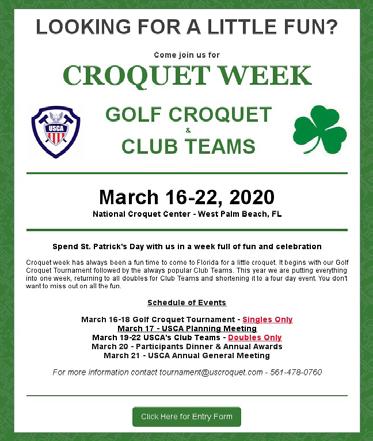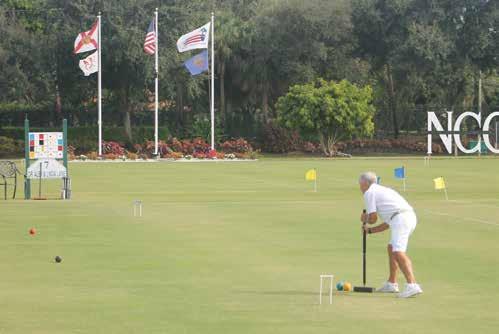
4 minute read
Leroy Niemen's Brush with Croquet
Brush with Croquet LEROY NEIMAN’S Brush with Croquet
Unique images tie one of America’s most well-known impressionist painter to American croquet history By Jim Bast

Leroy Neiman
LeRoy Neiman was an American artist well-known for brilliantly colorful paintings of sports events and musicians. His career took off after he met Hugh Hefner while working as a freelancer in Chicago. Hefner engaged Neiman as an illustrator for Playboy Magazine where he focused on illustrations depicting leisure around the world. He provided images for the Olympics in 1960 and that relationship continued through 1984. He produced art for many of the major sporting events of the world, including Super Bowls, Wimbledon, PGA, the Kentucky Derby and the World Series. He was born in 1921 in St. Paul, Minn., and married Janet Byrne in 1957. After living and working in New York City for most of his career, he passed away in 2012.

When I began playing tournament croquet in 1981, I was not thrilled about the requirement to wear white. Because I had to comply, I had some plus-fours made so I would at least be in a different white. In those days nobody had or wore plus-fours, which are the baggy knickers generally associated with golf. Of course, now they are everywhere. In 1982, during the National Championship held in Central Park in New York, I was wearing them and noticed during one of my games that my colleague from the Arizona Croquet Club, Stan Patmor, was leaning on the fence chatting with a man nearly the entire game.
22 | croquetamerica.com Neiman’s Fuller Court painting appeared in the July 1973 issue of Playboy Magazine. Image of Leroy Neiman provided by Wikimedia Commons/Creative Stuff
Afterward, I asked Stan, “Who were you talking to?” He replied, “Don’t you know who that was? It was LeRoy Neiman.” “Really? What was he doing here?” “Sketching you,” says Patmor. Several years later, I began searching Neiman catalogs in the vain hope that he had developed the sketch into a painting. However, no painting was found. Then, assuming he never threw anything away, I began a clueless quest to contact his agents, and eventually, his estate (Neiman passed in 2012) to try and verify the sketch existed and to locate it. Frankly, I had given up. Last year on our spring break trip to New York, my wife Cynthia and I did our usual wandering into random galleries to enjoy the works. The Franklin Bowles Gallery had several Neiman pieces and I told them my story. Their gallery happens to have a relationship with the Neiman Foundation, which supports many worthy causes, especially lesseradvantaged youth in art causes. Their curator was meeting with the Foundation in just a few days. That meeting produced the sketch we were after. In the faded, camera snapshot that was taken almost certainly on the same day the Neiman sketch was made, you can see Kiley Jones and Jack Osborn on the right.
The recovered LeRoy Neiman sketch.


Jim Bast in play in Central Park in 1982. Photo provided by Bast.
After our find at the Franklin Bowles gallery in New York, I thought to share the image of a Neiman print we had acquired around 2010. Considering that there were few known Neiman images of croquet, I was interested in their feedback. I did already have some background as I had emailed Ted Prentis right after purchasing the piece. At that time, he had immediately replied that it was Andy Fuller’s court on First Neck Lane in Southampton, N.Y. He also said he was there the day Neiman created the image and met the artist. We knew we almost certainly had an inexpensive reproduction (since verified) and at the time I did not pursue any further information with Prentis. Alas, I now regret that. Additional research revealed that Andy Fuller was a US Croquet Hall of Fame member and had been an oil man from Texas and Princeton. He had strong ties to the Bermuda Croquet Club and some of the people I contacted for feedback feel the image bears a connection to that club. It seems unlikely that anyone shown in the image is still living, but I was wellacquainted with many players from that era. The man at front right resembles Dick Pearman and the distinctive patterned jackets he was known to wear with his whites. The man at the back right resembles John Young, ascot and all, and his grandson, John Young III, concurs that it could be his grandfather. The beautiful, seated woman with a poodle is intriguing, as is the man smoking a pipe while playing in non-whites. Soon, the Franklin Bowles gallery discovered and relayed further information. The painting first appeared in the July 1973 issue of Playboy Magazine
as part of a six-page piece by Neiman called “Summer of ‘72.” The article features a series of “Quick sketches…” of leisure time in the Hamptons. And the notation under the croquet image in the magazine clearly identifies it as the Fuller Estate in Southampton. For me, 1972 would fit the puzzle nicely. Prentis would have been 23 or 24, extremely involved with croquet, and working on Wall Street, quite possibly for Al Heath. That, of course, predates the formation of the USCA, but the seeds were sprouting already, and Bermuda Croquet Club was one of the original USCA clubs. Efforts are underway to locate the original art, if it still exists. Meanwhile, if anyone thinks they have clues about the history or content of this piece, please contact the Croquet News at uscacroquetnews@yahoo.com.








